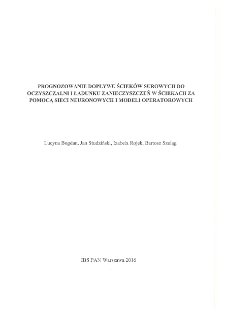- Search in all Repository
- Literature and maps
- Archeology
- Mills database
- Natural sciences
Advanced search
Advanced search
Advanced search
Advanced search
Advanced search

Object
Title: Prognozowanie dopływu ścieków surowych do oczyszczalni i ładunku zanieczyszczeń w ściekach za pomocą sieci neuronowych i modeli operatorowych * A Data Mining approach to the prediction of substrate load and mixed liquor suspended solid
Subtitle:
Raport Badawczy = Research Report ; RB/50/2016/03
Publisher:
Instytut Badań Systemowych. Polska Akademia Nauk ; Systems Research Institute. Polish Academy of Sciences
Place of publishing:
Description:
3, 48-71 stron ; 21 cm ; Bibliografia s. 68-71
Abstract:
This paper presents the methodology of modelling the mixed liquor suspended solid and food-to-mass ratio. The statistical models for the predictions of the wastewater influent (Q), biochemical oxygen demand (BOD5) and mixed liquor suspended solids (MLSS) were developed. Due to the fact that BOD5 determination is difficult to perform, the possibility of predicting this wastewater quality index using the wastewater influent and the COD data was analysed. To determine 11:LSS, the measurements of BOD5, COD, TSS, TN and NH4+, and also of the bioreactor operational parameters (recirculation rate, sludge pH and temperature, and amount of excess sludge removed) were applied. Because of high costs of determining wastewater quality indicators, the possibility of predicting those quantities on the basis of the flow rate recorded in the last measurements was taken in to account. The analyses performed for the paper made it possible to assess the impact of errors of wastewater quality prediction on the results of modelling of the food-to-mass ratio and mixed liquor suspended solids.
Relation:
Raport Badawczy = Research Report
Detailed Resource Type:
Resource Identifier:
Source:
Language:
Language of abstract:
Rights:
Licencja Creative Commons Uznanie autorstwa 4.0
Terms of use:
Zasób chroniony prawem autorskim. [CC BY 4.0 Międzynarodowe] Korzystanie dozwolone zgodnie z licencją Creative Commons Uznanie autorstwa 4.0, której pełne postanowienia dostępne są pod adresem: ; -
Digitizing institution:
Instytut Badań Systemowych Polskiej Akademii Nauk
Original in:
Biblioteka Instytutu Badań Systemowych PAN
Projects co-financed by:
Access:
Object collections:
- Digital Repository of Scientific Institutes > Partners' collections > Systems Research Institute PAS > Books
- Digital Repository of Scientific Institutes > Partners' collections > Systems Research Institute PAS > Reports
- Digital Repository of Scientific Institutes > Literature > Books/Chapters
Last modified:
Oct 19, 2021
In our library since:
Sep 8, 2021
Number of object content downloads / hits:
44
All available object's versions:
https://rcin.org.pl./publication/245695
Show description in RDF format:
Show description in RDFa format:
Show description in OAI-PMH format:
Objects Similar
Studziński, Jan Szeląg, Bartosz
Studziński, Jan Rojek, Izabela Szeląg, Bartosz
Bogdan, Lucyna Rojek, Izabela Studziński, Jan Szeląg, Bartosz
Szeląg, Bartosz
Szeląg, Bartosz
Szeląg, Bartosz
Szeląg, Bartosz

 INSTYTUT ARCHEOLOGII I ETNOLOGII POLSKIEJ AKADEMII NAUK
INSTYTUT ARCHEOLOGII I ETNOLOGII POLSKIEJ AKADEMII NAUK
 INSTYTUT BADAŃ LITERACKICH POLSKIEJ AKADEMII NAUK
INSTYTUT BADAŃ LITERACKICH POLSKIEJ AKADEMII NAUK
 INSTYTUT BADAWCZY LEŚNICTWA
INSTYTUT BADAWCZY LEŚNICTWA
 INSTYTUT BIOLOGII DOŚWIADCZALNEJ IM. MARCELEGO NENCKIEGO POLSKIEJ AKADEMII NAUK
INSTYTUT BIOLOGII DOŚWIADCZALNEJ IM. MARCELEGO NENCKIEGO POLSKIEJ AKADEMII NAUK
 INSTYTUT BIOLOGII SSAKÓW POLSKIEJ AKADEMII NAUK
INSTYTUT BIOLOGII SSAKÓW POLSKIEJ AKADEMII NAUK
 INSTYTUT CHEMII FIZYCZNEJ PAN
INSTYTUT CHEMII FIZYCZNEJ PAN
 INSTYTUT CHEMII ORGANICZNEJ PAN
INSTYTUT CHEMII ORGANICZNEJ PAN
 INSTYTUT FILOZOFII I SOCJOLOGII PAN
INSTYTUT FILOZOFII I SOCJOLOGII PAN
 INSTYTUT GEOGRAFII I PRZESTRZENNEGO ZAGOSPODAROWANIA PAN
INSTYTUT GEOGRAFII I PRZESTRZENNEGO ZAGOSPODAROWANIA PAN
 INSTYTUT HISTORII im. TADEUSZA MANTEUFFLA POLSKIEJ AKADEMII NAUK
INSTYTUT HISTORII im. TADEUSZA MANTEUFFLA POLSKIEJ AKADEMII NAUK
 INSTYTUT JĘZYKA POLSKIEGO POLSKIEJ AKADEMII NAUK
INSTYTUT JĘZYKA POLSKIEGO POLSKIEJ AKADEMII NAUK
 INSTYTUT MATEMATYCZNY PAN
INSTYTUT MATEMATYCZNY PAN
 INSTYTUT MEDYCYNY DOŚWIADCZALNEJ I KLINICZNEJ IM.MIROSŁAWA MOSSAKOWSKIEGO POLSKIEJ AKADEMII NAUK
INSTYTUT MEDYCYNY DOŚWIADCZALNEJ I KLINICZNEJ IM.MIROSŁAWA MOSSAKOWSKIEGO POLSKIEJ AKADEMII NAUK
 INSTYTUT PODSTAWOWYCH PROBLEMÓW TECHNIKI PAN
INSTYTUT PODSTAWOWYCH PROBLEMÓW TECHNIKI PAN
 INSTYTUT SLAWISTYKI PAN
INSTYTUT SLAWISTYKI PAN
 SIEĆ BADAWCZA ŁUKASIEWICZ - INSTYTUT TECHNOLOGII MATERIAŁÓW ELEKTRONICZNYCH
SIEĆ BADAWCZA ŁUKASIEWICZ - INSTYTUT TECHNOLOGII MATERIAŁÓW ELEKTRONICZNYCH
 MUZEUM I INSTYTUT ZOOLOGII POLSKIEJ AKADEMII NAUK
MUZEUM I INSTYTUT ZOOLOGII POLSKIEJ AKADEMII NAUK
 INSTYTUT BADAŃ SYSTEMOWYCH PAN
INSTYTUT BADAŃ SYSTEMOWYCH PAN
 INSTYTUT BOTANIKI IM. WŁADYSŁAWA SZAFERA POLSKIEJ AKADEMII NAUK
INSTYTUT BOTANIKI IM. WŁADYSŁAWA SZAFERA POLSKIEJ AKADEMII NAUK




































